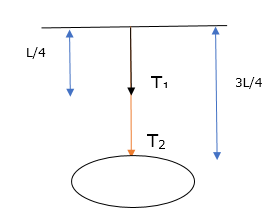A rod of length L is pivoted at one end and is rotated with a uniform angular velocity in a horizontal plane. Let T1 and T2 be the
tensions at the points L/4 and 3L/4 away from the pivoted ends.
Let us take a rod of uniform mass per unit length (m/L), now its mass beyond a distance ‘r’ from the pivot is = m(L-r).
This mass will be assumed to be concentrated at middle of the part (L-r) length. So, distance of this concentrated mass from the pivot point = (L+r)/2. Now the force due to circular motion acting along its length is equal to tension at a point ‘r’ away from the pivot point. =m× (L-r) × ![]() (L+r)/2 = m×
(L+r)/2 = m× ![]() × (
× (![]()
So, it is clear from the above equation that as r increases tension in
the rod decreases.

2